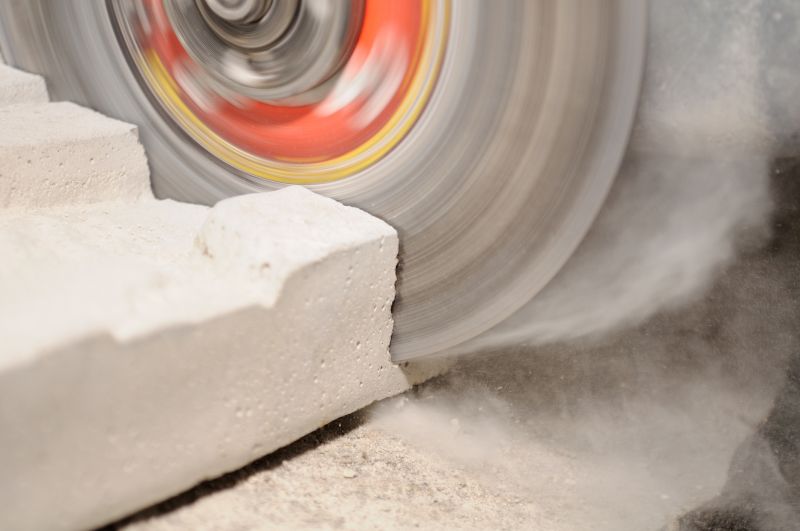Top-Rated Tools For Concrete Cuttings and Modifications
Compare leading products that offer enhanced control, safety features, and efficiency for all your concrete cutting needs.
 Concrete cutting is a specialized task that requires the right tools and equipment to ensure safety and precision. Whether undertaking small repairs or large-scale construction projects, selecting appropriate products can significantly impact the efficiency and quality of the work. From handheld tools to heavy-duty machinery, the variety of options available caters to different project sizes and complexity levels. Proper understanding of the products can help users in Des Moines, IA, and beyond make informed decisions suited to their specific needs.
Concrete cutting is a specialized task that requires the right tools and equipment to ensure safety and precision. Whether undertaking small repairs or large-scale construction projects, selecting appropriate products can significantly impact the efficiency and quality of the work. From handheld tools to heavy-duty machinery, the variety of options available caters to different project sizes and complexity levels. Proper understanding of the products can help users in Des Moines, IA, and beyond make informed decisions suited to their specific needs.
Top Overall Option
Heavy-Duty Concrete Cutting Saw
A versatile and robust concrete cutting saw designed to handle a wide range of applications. Equipped with a powerful motor and a durable blade system, it offers precise cuts for both small and large projects. Its ergonomic design ensures ease of handling and safety during operation, making it suitable for professional contractors and serious DIYers alike.
Types of Products For Concrete Cuttings
Handheld Concrete Saws
Portable and lightweight, ideal for small-scale cuts and detailed work.
Walk-Behind Concrete Saws
Larger, motorized saws suitable for straight cuts in sidewalks, driveways, and slabs.
Core Drills
Specialized drills used for creating precise holes in concrete surfaces.
Diamond Blades
High-performance blades designed for cutting through tough concrete and masonry materials.
Cutting Wheels and Discs
Versatile accessories for angle grinders to perform smaller cuts and detailed work.
Wet Cutting Attachments
Tools with water feed options to reduce dust and cool blades during cutting.
Reciprocating Saws with Diamond Blades
Multi-purpose saws capable of making various cuts in concrete and other hard materials.
Turbo Segmented Blades
Blades with a segmented rim for fast, aggressive cuts in concrete.
Segmented Rim Blades
Ideal for rough cuts and heavy-duty applications.
Continuous Rim Blades
Designed for smooth, clean cuts in delicate or finished concrete surfaces.
Concrete Chainsaws
Specialized chainsaws for cutting through thick concrete walls and slabs.
Angle Grinders with Diamond Blades
Compact tools for small cuts, grinding, and surface finishing.
Hydraulic Concrete Cutters
Heavy-duty equipment powered by hydraulic systems for large-scale projects.
Electric Concrete Cutters
Corded or cordless options suitable for various indoor and outdoor applications.
Gas-Powered Concrete Saws
Portable and powerful, ideal for remote job sites without easy access to power sources.
Popular Choices
Popular for small repairs and detailed cuts, offering portability and ease of use.
Commonly used for large slabs and pavement cuts, appreciated for their efficiency.
Widely selected for their durability and cutting performance across various projects.
Favored for precise hole creation in concrete surfaces, useful in plumbing and electrical work.
Preferred for reducing dust and extending blade life during cutting tasks.
Chosen for aggressive and quick cuts in demanding applications.
Popular for heavy-duty cutting where speed is prioritized over finish.
Selected for clean, smooth cuts, especially in finished concrete surfaces.
Commonly used for smaller, detailed cuts and surface grinding.
Valued for their power and precision in large-scale construction environments.
Popular for indoor work and projects requiring a quieter, cleaner operation.
Chosen for portability and power on remote or outdoor job sites.
When approaching concrete cutting, safety should be a primary concern. Using the correct protective gear, along with reliable equipment, minimizes risks associated with dust, debris, and noise. The durability and performance of cutting tools depend on factors such as blade material, motor power, and compatibility with different concrete types. It is also important to consider the ease of use and maintenance requirements of each product to ensure long-term usability.
For professional contractors and DIY enthusiasts alike, investing in versatile and high-quality tools can streamline the process and improve results. Properly selected equipment can handle various cutting tasks, including straight cuts, curved cuts, and hole drilling. Additionally, accessories like blades, diamond segments, and adapters expand the functionality of core tools, making them adaptable to different project specifications. Knowing what to look for in terms of product features can help users in Des Moines find solutions that fit their scope and budget.
Overall, the right products for concrete cutting combine safety, efficiency, and durability. By choosing tools that match the specific demands of the project, users can achieve cleaner cuts with less effort and downtime. Whether for small repairs or large construction jobs, the right equipment can make a significant difference in the outcome and overall experience.
Key Buying Considerations
- Type of cutting task (e.g., straight, curved, hole drilling) to determine the appropriate tool.
- Project scale and size to select suitable equipment, from handheld tools to large saws.
- Blade compatibility and type, including diamond segments, turbo blades, or continuous rims.
- Power source preferences, such as electric, gas-powered, or hydraulic, based on mobility needs.
- Cutting depth capacity to ensure the tool can handle the required thickness of concrete.
- Ease of operation and ergonomic design for safety and comfort during extended use.
- Dust and debris management features like water feed or dust extraction systems.
- Durability and build quality to withstand demanding job site conditions.
- Maintenance requirements and availability of replacement parts or accessories.
- Noise levels, especially for indoor projects or noise-sensitive environments.
- Budget constraints balanced with desired performance and longevity.
- Availability of accessories and additional blades for versatility.
- Compatibility with existing equipment or tools in your toolkit.
- Safety features such as blade guards, emergency stop, and protective gear compatibility.
- Local support and availability of service or repair options.
